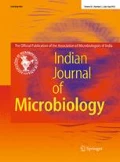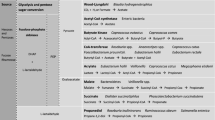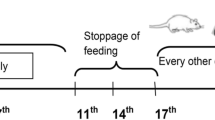Abstract
The main goal of our study was to evaluate the effect of the individual administration of five lyophilized lactic acid bacteria strains (Lactobacillus fermentum 428ST, Lactobacillus rhamnosus E4.2, Lactobacillus plantarum FCA3, Lactobacillus sp. 34.1, Weissella paramesenteroides FT1a) against the in vitro simulated microbiota of the human colon using the GIS1 system. The influence on the metabolic activity was also assessed by quantitative determination of proteins and polysaccharides at each segment of human colon. The obtained results indicated that the lactic acid bacteria L. rhamnosus E4.2 and W. paramesenteroides FTa1 had better efficiency in synthesising exopolysaccharides and also a better probiotic potential and therefore could be recommended for use in probiotics products or food industry.


Similar content being viewed by others
References
Ljung A, Wadstrom T (2006) Lactic acid bacteria as probiotics. Curr Issues Intest Microbiol 7:73–90
Guinane CM, Cotter PD (2013) Role of the gut microbiota in health and chronic gastrointestinal disease: understanding a hidden metabolic organ. Ther Adv Gastroenterol 6:295–308. doi:10.1177/1756283X13482996
FAO/WHO (2001) Health and nutritional properties of probiotics in food including powder milk with live lactic acid bacteria. Cordoba, Argentina, October 1–4
Araya MML, Reid G, Sanders ME, Stanton C (2002) Guidelines for the evaluation of probiotics in food. Jt. FAO/WHO Work. Group: London, UK; Ontario, Canada
Sanchez B, Urdaci M, Margolles A (2010) Extracellular proteins secreted by probiotic bacteria as mediators of effects that promote mucosa–bacteria interactions. Microbiology 156:3232–3242. doi:10.1099/mic.0.044057-0
Boesten RJ, De Vos WM (2008) Interactomics in the human intestine: Lactobacilli and Bifidobacteria make a difference. J Clin Gastroenterol 42:S163–S167. doi:10.1097/MCG.0b013e31817dbd62
Makelainen H, Forssten S, Olli K, Granlund L, Rautonen N, Ouwehand AC (2009) Probiotic lactobacilli in a semi-soft cheese survive in the simulated human gastrointestinal tract. Int Dairy J 19:675–683. doi:10.1016/j.idairyj.2009.06.005
Xu X, Xu P, Ma C, Tang J, Zhang X (2013) Gut microbiota, host health, and polysaccharides. Biotechnol Adv 31:318–337. doi:10.1016/j.biotechadv.2012.12.009
Ruas-Madiedo P, De Los Reyes-Gavilán CG (2005) Methods for the screening, isolation and characterization of exopolysaccharides produced by lactic acid bacteria. J Dairy Sci 88:843–856. doi:10.3168/jds.S0022-0302(05)72750-8
Doleyres Y, Schaub L, Lacroix C (2005) Comparison of functionality of exopolysaccharides produced in situ or added as bio-ingredients on yoghurt properties. J Dairy Sci 88:4146–4156. doi:10.3168/jds.S0022-0302(05)73100-3
Silva PDLD, Bezerra MDF, Santos KMOD, Correia RTP (2015) Potentially probiotic ice cream from goat’s milk: characterization and cell viability during processing, storage and simulated gastrointestinal conditions. LWT Food Sci Technol 62:452–457. doi:10.1016/j.lwt.2014.02.055
Vamanu E, Pelinescu D, Marin I, Vamanu A (2012) Study of probiotic strains viability from PROBAC product in a single chamber gastrointestinal tract simulator. Food Sci Biotechnol 21:979–985. doi:10.1007/s10068-012-0128-8
Vamanu E, Pelinescu D, Avram I, Nita S, Vamanu A (2013) Study of PROBAC product influence on infant microbiota in a single-chamber colonic fermentation model GIS1. Ann Microbiol 63:1029–1038. doi:10.1007/s13213-012-0558-9
Dimitrijević A, Velickovkc D, Rikalovic M, Avramovic N, Milosavic N, Jankov R, Karadzic I (2011) Simultaneous production of exopolysaccharide and lipase from extremophylic Pseudomonas aeruginosa san-ai strain: a novel approach for lipase immobilization and purification. Carbohydr Polym 83:1397–1401. doi:10.1016/j.carbpol.2010.10.005
Vamanu E, Nita S (2013) Antioxidant capacity and the correlation with major phenolic compounds, anthocyanin, and tocopherol content in various extracts from the wild edible Boletus edulis mushroom. Biomed Res Int, Article ID 313905. doi:10.1155/2013/313905
Bradford MM (1976) A rapid and sensitive method for the quantitation of microgram quantities of protein utilizing the principle of protein-dye binding. Anal Biochem 7:248–254. doi:10.1016/0003-2697(76)90527-3
Delzenne NM, Cani PD (2011) Interaction between obesity and the gut microbiota: relevance in nutrition. Ann Rev Nutr 31:15–31. doi:10.1146/annurev-nutr-072610-145146
Nwodo UU, Green E, Okoh AI (2012) Bacterial exopolysaccharides: functionality and prospects. Int J Mol Sci 13:14002–14015. doi:10.3390/ijms131114002
Patel S, Majumder A, Goyal A (2012) Potentials of exopolysaccharides from lactic acid bacteria. Indian J Microbiol 52:3–12. doi:10.1007/s12088-011-0148-8
Shamekhi F, Shuhaimi M, Ariff A, Manap YA (2013) Cell viability of microencapsulated Bifidobacterium animalis subsp. lactis under freeze-drying, storage and gastrointestinal tract simulation conditions. Folia Microbiol 58:91–101. doi:10.1007/s12223-012-0183-9
Nelson-Dooley C, Olmstead SF (2015) The microbiome and overall health part 5: the oropharyngeal microbiota’s far-reaching role in immunity, gut health, and cardiovascular disease. Complementary Prescriptions. http://www.cpmedical.net/newsletter/the-microbiome-and-overall-health-part-5-the-oropharyngeal. Accessed 12 June 2015
Probert HM, Gibson GR (2004) Development of a fermentation system to model sessile bacterial populations in the human colon. Biofilms 1:13–19. doi:10.1017/S1479050503001029
Al-Okbi SY, Mohamed DA, Donya SM, Abd El Khalek AB (2011) Role of Bifidobacterium bifidum and plant food extracts in improving microflora and biochemical and cytogenetic parameters in adjuvant arthritis. Grasas Aceites 62:308–320. doi:10.3989/gya.089810
Prakash S, Tomaro-Duchesneau C, Saha S, Cantor A (2011) The gut microbiota and human health with an emphasis on the use of microencapsulated bacterial cells. J Biomed Biotechnol, Article ID 981214. doi:10.1155/2011/981214
Desai AR, Powell IB, Shah NP (2004) Survival and activity of probiotic Lactobacilli in skim milk containing prebiotics. J Food Sci 69:FMS57–FMS60. doi:10.1111/j.1365-2621.2004.tb13371.x
Soccol CR, Vandenberghe LPS, Spier MR, Medeiros ABP, Yamaguishi CT, De Dea Lindner J, Pandey A, Thomaz-Soccol V (2010) The potential of probiotics: a review. Food Technol Biotechnol 48:413–434
Butel MJ (2014) Probiotics, gut microbiota and health. Med Mal Infect 44:1–8. doi:10.1016/j.medmal.2013.10.002
Acknowledgments
This research was supported by the National Centre for Program Management PN-II-PT-PCCA-2011-3.1-0969/2012 coordinated by Romanian Agency for Scientific Research.
Author information
Authors and Affiliations
Corresponding author
Rights and permissions
About this article
Cite this article
Moroeanu, V.I., Vamanu, E., Paun, G. et al. Probiotic Strains Influence on Infant Microbiota in the In Vitro Colonic Fermentation Model GIS1. Indian J Microbiol 55, 423–429 (2015). https://doi.org/10.1007/s12088-015-0542-8
Received:
Accepted:
Published:
Issue Date:
DOI: https://doi.org/10.1007/s12088-015-0542-8




